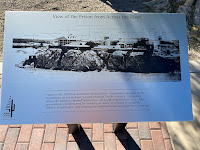After Yuma we hung out in Arizona and New Mexico before working our way back to Tacoma the end of April. We only stopped at a couple new noteworthy locations on the entire drive. Although we did drive across the salt flats west of Salt Lake City for the first time which was interesting.
The first one I want to mention is the California Trail Interpretive Center near Elko, Nevada. We decided to take a break here with no expectations. It turned out to be a wonderful, informative place. It's worth a stop if you are going across I-80 in Nevada.
We did go out of our way for the next stop of interest. Over our years of Meandering in our RV we've been to dozens of Corp of Discovery (Lewis and Clark Expedition) historic sites with many being remote and we've found them all interesting. Many years ago we saw a reference to "Pomp" (who's Pomp? See below) having died and been buried at a remote location in southeast Oregon. This went into my list of future places to seek out when in the area (why not?). When planning our route home on this trip I specifically planned the route to go here and then across US 20 to see central Oregon which was another long time goal. Missions accomplished.
So who was Pomp? He was Jean Baptiste Charbonneau, son of Sacagawea, born at Fort Mandan in 1805 in present-day North Dakota, just north of Bismarck. William Clark gave him the nickname Pompey. He went on to have an interesting life (his Wiki).
Here is a link to the Grave site.
You could also go to my post for August of 2015 when we visited the Fort Mandan State Historic Site. That might be where I saw the reference to the Pomp burial site, but I'm not sure.
 |
| Jean Baptist Charbonneau grave site |
 |
| Jean Baptist Charbonneau grave site |





